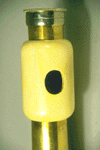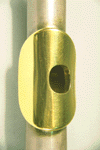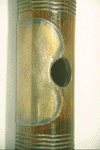

Transverse Flute Elements Named in This Catalog | Conventions and Definitions | Key and Key Mounting Nomenclature
by Robert E. Sheldon and Carol Lynn Ward Bamford,
Library of Congress Music Division Staff
The transverse flute works most efficiently when the embouchure piece or joint has a wall thickness sufficient for the embouchure hole to be adequately undercut. This practice, making the hole larger on the inside than on the outside of the instrument, addresses several acoustical aspects without requiring mechanical devices. Undercutting is critically important, for while it enables both fingerholes and embouchure to be large enough at the bore to produce optimum voicing, pitch, and volume, it allows those same holes to be small enough in their surface dimensions to be covered by the fingertips or, in the case of the embouchure, to accommodate the player's airstream to the best advantage. Such adjustments cannot be taken very far on simple folk instruments with thin walls, but the design of European transverse flutes traditionally includes wall thickness adequate for wood, ebonite (hard rubber), and ivory instruments to achieve proper embouchure hole dimensions. For sheet metal instruments the wall thickness is increased at the embouchure in one of the following ways.
The earlier form involves an embouchure barrel that surrounds the sheet metal tube of the head joint at its embouchure hole with a short cylinder of wood or ivory, increasing the outer diameter to that of a typical wood or ivory head joint. The embouchure is bored and undercut as if made from one material. The Miller Collection has splendid examples, such as two of the earliest of Theobald Boehm's 1847 model cylindrical bore flutes, DCM 0652, with a boxwood embouchure barrel, and DCM 0470, with an ivory embouchure barrel. A slightly later variation of this earlier form, DCM 0043, involved a three-part sandwich of materials that added to the barrel an outer metal veneer, usually of the same metal as the instrument. It was closed neatly or decoratively at the ends of the barrel so that the middle nonmetallic layer would be visible only at the embouchure hole. In some cases the inner wood or other material was omitted, leaving a thermally useful airspace with the embouchure hole and undercutting achieved by soldering in a tapered tube of the necessary dimensions.

|

|

|
| Detail of DCM 0470
Embouchure barrel |
Detail of DCM 0043
Embouchure barrel |
Detail of DCM 0161
Embouchure plate |
A still later version of the same soldered embouchure hole tube assembly, DCM 0161, involves an embouchure plate that eliminates most of the embouchure barrel, leaving only a large, usually oval, plate containing the embouchure hole and standing a few millimeters above the surface of the head joint tubing. The embouchure hole tube (the riser) has a small bottom flange large enough for soft soldering the entire unit (if all metallic) to the head joint. It is this arrangement which is encountered on most modern metal flutes. Early versions used other materials for the plate and therefore required mechanical joining rather than soldering, usually with a pair of decorative screws joining the plate to tapped lugs soldered to the body tubing.
Lip plate refers to any sheet metal veneer, usually an oval (often inlaid flush with the outer surface of the head joint), which surrounds the embouchure hole of a wooden or other non-metal flute, such as DCM 0449. It may be cemented and/or tacked to the tubing.
 |
 |
|
Detail of DCM 0449
Lip plate |
Detail of DCM 0073
Lip plate ferrule |
Lip plate ferrule, DCM 0073, refers to a variation of the lip plate that encircles the head joint at the embouchure area with a sheet metal cylinder resembling the embouchure barrel and usually recessed flush with the outer surface. The lip plate and lip plate ferrule for nonmetal flutes were additions for presenting a metallic embouchure surface for those players who preferred it. The lip plate ferrule was also sometimes applied to reduce cracking of the wood. In some cases, an entire nineteenth- or early-twentieth-century wooden head joint may be sheathed with a sheet metal veneer, usually nickel silver. Such instruments are usually metal-lined, frequently with a double metal tube forming a tuning slide within the two-part head joint. The lower of those two sections is termed the barrel or head joint barrel, perhaps due to its similarity to the barrel joint of a clarinet. The embouchure barrel and embouchure plate of metal flute head joints may provide the player with a more attractive material for the embouchure, such as gold or gold plate, but their main purpose is to improve the acoustical properties of the instrument through greater wall thickness at the embouchure.
Thinned or thinned wood refers to a process developed in the nineteenth century to reduce the wall thickness of cylindrical bore wood flutes, thereby supposedly increasing the vibrancy of the tube. Similar to the earlier method of cutting key blocks, it required a high degree of careful handwork and an instrument with parts that could be finished by machine. After drilling the bore, the outer dimension was turned on a lathe to achieve a fairly thin wall between toneholes or above or below tonehole groupings. This process left wider outer diameter turnings or beads between the thinned areas, each of which would be bored for a tonehole seat made of the body wood or other material. The rest of each such bead or ferrule--well over half the circumference of the tube--would be cut away and finished by hand. Only the head joint was relatively easy to finish, requiring only one such hand operation where the embouchure plate was left standing from cut-away material.
|
|
|
Detail of DCM 0024
Integral Tone Hole Elevations |
Thinned wood flutes were very expensive due to the handwork and time required, and consequently they are rare. Perhaps the most impressive example in the Miller Collection is DCM 0024, an unfinished boxwood alto flute in G by Boehm & Mendler. It is unfinished only with respect to its keywork, which was never applied to the instrument. The wood thinning is thus all the more convenient to examine.